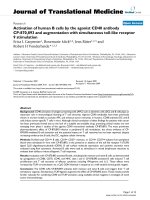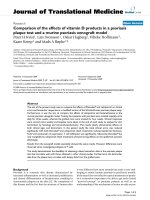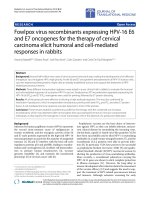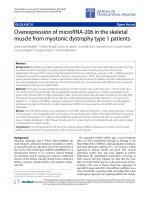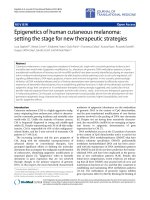báo cáo hóa học:" Summary of the primer on tumor immunology and the biological therapy of cancer" ppt
Bạn đang xem bản rút gọn của tài liệu. Xem và tải ngay bản đầy đủ của tài liệu tại đây (162.64 KB, 5 trang )
BioMed Central
Page 1 of 5
(page number not for citation purposes)
Journal of Translational Medicine
Open Access
Editorial
Summary of the primer on tumor immunology and the biological
therapy of cancer
Yufeng Li
1
, Shujuan Liu
1
, Kim Margolin
2
and Patrick Hwu*
1
Address:
1
Department of Melanoma Medical Oncology, the University of Texas, M. D. Anderson Cancer Center, Houston, TX, USA and
2
Department of Medicine Division of Oncology, University of Washington, Seattle, WA, USA
Email: Yufeng Li - ; Shujuan Liu - ; Kim Margolin - ;
Patrick Hwu* -
* Corresponding author
Abstract
The International Society for Biological Therapy of Cancer (iSBTc) is one of the "premier
destinations for interaction and innovation in the cancer biologics community". It provides a primer
course each year during the annual meeting to address the most important areas of tumor
immunology and immunotherapy. The course has been given by prominent investigators in the area
of interest, covering the core principles of cancer immunology and immunotherapy. The target
audience for this program includes investigators from academic, regulatory, and biopharmaceutical
venues. The program goal is to enable the attendees to learn the current status and the most recent
advances in biologic therapies, and to leverage this knowledge towards the improvement of cancer
therapy. The 2008 immunologic primer course was held on October 30 at the 23rd Annual meeting
of iSBTc in San Diego, CA. Nine internationally renowned investigators gave excellent
presentations on different topics. The topics covered in this primer included: (1) cytokines in
cancer immunology; (2) anti-angiogenic therapy; (3) end stage: immune killing of tumors; (4)
blocking T cell checkpoints; (5) approach to identification and therapeutic exploitation of tumor
antigens; (6) T regulatory cells; (7) adoptive T cell therapy; (8) immune monitoring of cancer
immunotherapy; and (9) immune adjuvants. We summarized the topics in this primer for public
education. The related topic slides and schedule can be accessed online />meetings/am08/primer08.
Cytokines in cancer immunology
The development of anti-cancer cytokines is an active area
for investigators in the field of cancer immunotherapy.
Dr. Mario Sznol, MD (Yale University School of Medi-
cine) gave a comprehensive topic on the application of
cytokines in cancer immunotherapy. Both immune or
non-immune cells can be the focus of biological rationals
for cytokine therapy, including: 1) T cells: to enhance the
development, proliferation and/or function of either
endogenous or adoptively transferred effector T cells; 2)
NK cells: to enhance NK activity and improve ADCC; 3)
tumor cells: to upregulate Ag and MHC expression, or
induce an anti-proliferative effect; 4) DC/APC: to generate
and mature DC/APC in vitro, and to increase DC/APC
number and function in vivo.
Although over 20 cytokines have been developed for the
treatment of cancer, only IL-2, IFN-α and TNF-α have
been approved in the US and/or Europe for immunologic
anti-cancer therapy. Multiple issues for clinical develop-
Published: 28 January 2009
Journal of Translational Medicine 2009, 7:11 doi:10.1186/1479-5876-7-11
Received: 27 December 2008
Accepted: 28 January 2009
This article is available from: />© 2009 Li et al; licensee BioMed Central Ltd.
This is an Open Access article distributed under the terms of the Creative Commons Attribution License ( />),
which permits unrestricted use, distribution, and reproduction in any medium, provided the original work is properly cited.
Journal of Translational Medicine 2009, 7:11 />Page 2 of 5
(page number not for citation purposes)
ment of cytokines have been highlighted over decades of
studies, such as their context-dependent biological effects,
secondary effects, and differences in response between
individuals. IL-2 was one of the first cytokines to be
applied to cancer therapy. IL-2 induces T cell activation
and proliferation and stimulates NK cell cytotoxicity;
however, IL-2 also causes vascular leak syndrome, which
can lead to significant side effects. IL-2 regimens have
been tested in several types of cancers, with a 15%
response rate only in human metastatic renal cell carci-
noma and melanoma. Adoptive cell transfer of tumor
infiltrating lymphocytes to lymphodepleted patients with
melanoma in combination with high dose IL-2 has been
shown to achieve clinical responses in the range of 50%.
However, minimal activity of IL-2 in the treatment of
other cancers has been observed. Mechanistic studies
involving T cells activation, T regulatory cells and B7 co-
stimulatory family members are under investigation to
address how IL-2 works or fails in therapy. IL-2, IL-15 and
IL-21 all belong to the common gamma chain receptor
family. Targeting NK, NKT and memory CD8
+
T cells, IL-
15 exerts its functions preferentially through trans-presen-
tation. Murine models demonstrated that IL-15 enhances
in vivo anti-tumor activity of adoptively transferred T cells,
which is further enhanced in combination with an anti-IL-
2 antibody. IL-21 may be a promising candidate for cancer
immunotherapy as it has pleiotropic roles in immune
cells, yet does not support Treg function. A combination
of IL-15 and IL-21 may be a choice for future therapeutic
regimens, as suggested by some mouse studies. The clini-
cal experience with IL-12 was also summarized; local
administration is recommended due to its excessive sys-
temic toxicity. Other cytokines, such as IL-6, IL-7, Th17,
and TGF-β were also discussed in this lecture. Future
applications of new cytokines include in vitro expansion
of antigen-specific T cells and the support for adoptively
transferred cells; local application as a vaccine adjuvant;
antibodies to neutralize selected cytokines to enhance
immune responses; or combination uses, such as with
immune modulating monoclonal antibodies (such as
anti-CTLA4).
Anti-angiogenic therapy
Dr. David Cheresh (University of California, San Diego)
updated studies on targeting tumor angiogenesis by
blocking the VEGF/VEGFR pathway. Growth factors of the
VEGF and PDGF families function primarily in a paracrine
manner to promote angiogenesis (the sprouting of new
blood vessels from pre-existing ones) and vasculogenesis
(the generation of new blood vessels where no blood ves-
sels previously exist). Both angiogenesis and vasculogene-
sis play roles in the formation and maintenance of tumor
vasculature and the progression of cancer. VEGF and
PDGF bind their corresponding receptors to trigger recep-
tor autophosphorylation and the initiation of down-
stream signaling processes. The ligation of VEGFR-2 by
the majority of VEGF isoforms triggers the proliferation,
migration and survival of endothelial cells, which in
tumors form the framework of immature new neoplastic
vessels. The PDGFs play a role in the regulation of cell pro-
liferation, and function as growth signals for pericytes and
Vessel-Smooth-Muscle-Cells (VSMC) that line and stabi-
lize the nascent vessels formed by endothelial cells.
VEGF, through its receptor, attenuates PDGF-mediated
pericyte/VSMC coverage of blood vessels. The VEGF recep-
tor interacts with the PDGF receptor to inhibit PDGF sig-
naling. VEGFR-2 pathway blockade (Avastin) increases
pericyte coverage and normalizes tumor vessels. Besides
vascular cells and tumor cells, myeloid cells can also pro-
duce VEGF. In a myeloid-specific VEGF knock out mouse,
pericytic coverage was improved. Furthermore, Avastin
treatment achieved better tumor control in myeloid-spe-
cific VEGF knock out mice compared to wild-type mice.
Together, the data provides a mechanism to explain how
VEGF/VEGFR blockade increases pericyte coverage, and
also challenges us to utilize these agents to effectively treat
tumor.
End stage: immune killing of tumors
The ultimate goal of cancer immunotherapy is to lyse
tumor cells with immune mechanisms. Dr. William Mur-
phy (U.C. Davis School of Medicine) described the path-
ways towards immune-mediated tumor lysis. The basic
steps for immune effector cells to kill tumors include tar-
get recognition and conjugate formation, followed by
tumor lysis or growth arrest. Immune effector elements,
including T cells, NK cells, monocyte/macrophages, and
antibodies can directly kill tumors through lytic/cytostatic
mechanisms by secreting perforin/granzymes, or inducing
tumor cytostatis or apoptosis; or indirectly mediate tumor
inhibition via attacking tumor supportive elements such
as endothelial or stromal cells. Tumor cells escape
immune killing by blunting the basic requirements of
immune effector cell function and inducing an immuno-
suppressive environment. Thus, means to improve target
recognition and conjugation, enhance lysis potential, and
overcome tumor evasion, will lead to effective tumor kill-
ing. Based on the principles of immune killing of tumors,
strategies to augment anti-tumor immunity are under
investigation or already used for the treatment of cancer,
such as cytokine therapy to activate effector cells (Inter-
feron, IL-2, etc), chemoimmunotherapy (Doxorubicin),
molecular targeting (proteasome inhibition, HDAC
inhibitors), blocking anti-apoptotic machinery (antisense
to bcl-2), blocking immune suppression by tumor (COX2
inhibitors, blockade of TGF-β), augmenting effector cell
capacities (genetically engineered immune cells that sur-
vive and function better in immunosuppressive environ-
ments). Dr. Murphy also discussed the measurement of
Journal of Translational Medicine 2009, 7:11 />Page 3 of 5
(page number not for citation purposes)
tumor killing. As demonstrated, Bortezomib can sensitize
tumor cells to death by inhibiting NF-κB, reducing c-FLIP
and stabilizing p53. Bortezomib also enhances the killing
through NK cells, as was supported by in vitro and in vivo
long term tumorigenesis assays. The design of assays to
reflect and validate in vivo tumor killing mechanisms is
challenging. The in vitro assay may be used for the initial
screen, and multiple tumor cells, doses and mechanisms
of action with long-term assays should be tested for better
evaluation of killing efficacy potential. For in vivo models,
spontaneous tumors or slower growing orthotopic tumors
were suggested in order to mimic the natural tumor
microenvironment.
Blocking T cell checkpoints
The T cell response requires two signals: the first signal is
the recognition and binding of the T cell receptor (TCR) to
antigen bound within the major histocompatibility com-
plex (MHC) presented by APCs; the second is the binding
of costimulatory ligands, expressed on APC, to receptors
on the T cells. The discovery of multiple costimulatory
molecules that influence the course of T cell activation has
increased our appreciation of the complexity of the T cell
response. CD28 and cytotoxic T lymphocyte antigen 4
(CTLA-4) are the critical costimulatory receptors that
determine the early outcome of stimulation through TCR.
CTLA-4 plays a critical role in the down-regulation of T
cell responses. Its inhibition may restrict T cell activation
during both the initiation and progression of the antitu-
mor response. Thus, blockade of CTLA-4 inhibitory sig-
nals during T cell-APC interactions can result in enhanced
tumor immunity. Dr. Jim Allison (Memorial Sloan Ketter-
ing) reviewed the studies on the anti-CTLA-4 monoclonal
Ab to negate this "brake" function. He first presented
work using anti-CTLA-4 Ab alone or in combination with
other modalities to treat murine tumors. Activation of vas-
culature in tumors, extravasation and proliferation of T
cells, and increased ratios of Teff/Treg and IFN-γ/IL-10
were discovered to be the mechanisms of anti-tumor
effects of CTLA-4 blockade in mouse models. It was
shown that Teff cells are the major population accounta-
ble for the anti-tumor effects of anti-CTLA-4; CTLA-4
blockade in Tregs alone does not significantly contribute
to tumor control; while blocking CTLA-4 in both popula-
tions is necessary for an optimal anti-tumor response. He
then reviewed the studies of lpilimumab, a human CTLA-
4 monoclonal Ab, utilized in clinical trials. More than
3700 patients were treated with lpilimumab; clinical
responses have been seen in melanoma, renal, prostate,
ovarian and Hodgkins lymphoma. 15–20% of response
can be seen in melanoma as monotherapy, and this seems
to be increased when combined with vaccines. The
adverse effects of lpilimumab are manageable with
monthly administration, and can be alleviated by spacing
out treatments. The critical questions for further clinical
development of anti-CTLA-4 to be answered are: the
mechanisms involved in the anti-tumor effects; how to
distinguish responders from non-responders; the best
combinations with conventional therapies or vaccines.
Dr. Allison also updated data of other targets for check-
point blockade and possible candidates for cancer immu-
notherapy, such as PD-1, B7-H3 and B7x. In summary, the
data indicates that checkpoint blockade is a potential
strategy to unleash the immune system to maximize T cell
responses to multiple targets for cancer immunotherapy.
Approach to identification and therapeutic
exploitation of tumor antigens
Dr. Walter Urba (Earle A. Chiles Research Institute)
reviewed the approaches to identify and therapeutically
utilize tumor antigens. Tumor antigens can elicit immune
responses, which lead to tumor elimination. In most cases
in cancer, tumor cells transform and mutate frequently,
resulting in immune equilibrium and finally escape
immune surveillance. A rational way of fighting cancer is
to identify tumor antigens and utilize them in vaccines to
boost anti-tumor immunity. Many approaches have been
used to discover tumor antigens, including: 1. direct
immune approach, starting with T-cells or antibodies that
recognize tumors and identifying the antigens by cDNA
cloning techniques; 2. reverse immune approaches, start-
ing with candidate antigens that are over-expressed by
tumors and determining whether T-cells can recognize
these antigens. Numerous human tumor antigens have
been discovered using the above approaches, covering
shared tumor-specific antigens (MAGE, NY-ESO-1, etc),
antigens resulting from mutations (MUM-1, CDK4, etc.),
differentiation antigens (MART-1, gp100), overexpressed
antigens (p53, HER2/neu), and viral antigens (EBV,
HPV16). Ideally, a tumor antigen should be specific and
immunogenic, with multiple epitopes and high levels of
expression. Ideally, the antigen should be critical for
oncogenicity. Finally, the tumor antigen has to be clini-
cally proven to be efficacious in vaccine trials. For exam-
ple, the cancer/testis antigens (CT Ag) are a group of
prominent Ags, such as NY-ESO-1, MAGE, whose expres-
sion is restricted in tumors, testis and/or placenta, but not
in more than two non-germline normal tissues; CT anti-
gens are immunogenic in cancer patients; their expression
may be associated with tumor progression and with
tumors of high metastatic potential. Active immunization
of cancer patients targeting tumor antigens can be con-
ducted using different strategies, such as antigenic pep-
tides, whole proteins or virus-like particles; recombinant
viruses/bacteria/DNA encoding tumor Ag genes; or cells
expressing tumor Ags. So far, tumor Ag vaccination in clin-
ical trials has had disappointing results. Several issues
have been highlighted, such as loss of Ag expression or
MHC on tumor cells post treatment, and lack of sufficient
immune adjuvants or trafficking of T-cells to the tumor.
Journal of Translational Medicine 2009, 7:11 />Page 4 of 5
(page number not for citation purposes)
However, better antigen selection and methods to over-
come tumor escape should improve active cancer immu-
notherapy in the future.
T regulatory cells
The scientist who first described T regulatory cells (Treg),
Dr. Shimon Sakaguchi (Kyoto University, Japan), updated
Treg research in relation to the immunotherapy of cancer.
Ever since classical T regulatory cells were discovered uti-
lizing CD4
+
CD25
+
T cell depletion experiments, tumor
immunity has been closely examined in regard to Tregs.
Induction of anti-tumor immunity by CD4
+
CD25
+
Treg
depletion was first proved in mouse models. Anti-IL-2
treatment reduced CD25
+
Treg, and mice developed
autoimmune disease. IL-2 is crucial for self-tolerance
maintenance. Foxp3 is a master transcription factor in
Tregs, and Foxp3
+
Treg have constitutive expression of
CTLA-4. CTLA-4 blockade abrogates Treg suppression.
Further effective tumor immunity was provoked in Treg-
restricted-CTLA-4
-/-
mice. Through microarray analysis,
folate receptor 4 (FR4) was discovered to have high
expression on activated Treg cells. Functional analysis
indicated that FR4 differentiate activated Teff into Treg,
and its blockade leads to Treg depletion in vivo, in turn
improving tumor rejection. GITR is another molecule
preferentially expressed by Treg. DTA-1, an antibody for
GITR, can abrogate Treg suppression while not depleting
Treg, can reverse Teff/Treg ratio and increase CD4 T cell
infiltration into tumors, and can synergize with CTLA-4
blockade to enhance anti-tumor immunity. In summary,
several molecules associated with Treg function and main-
tenance can be targeted for cancer immunotherapy.
Adoptive T cell therapy
Dr. Philip Greenberg (Fred Hutchinson Cancer Research
Center & University of Washington) discussed three major
obstacles of adoptive cell therapy and strategies to over-
come them for better cancer immunotherapy. First, select
optimal tumor antigens for targeting. Active immuniza-
tion of characterized Ags has been explored for many
years and success remains limited. Adoptive cell therapy is
an alternative way to isolate and expand antigen specific T
cells for potent tumor immunity for the treatment of can-
cer. Although infused T cells infiltrate tumors and exhibit
tumor control in some patients, tumor antigen evasion
still remains a major problem. Thus, targeted antigen
selection is important for treatment. The solution is to
select over-expressed oncogenes indispensable for the
tumor phenotype. An effective isolation strategy by
enrichment of CD137
+
reactive T cells is especially helpful
for identifying rare responding T cells. As an example, a
novel WT1 epitope restricted by a class I allele was discov-
ered in >40% of leukemia patients. A phase-I clinical trial
with WT1 specific T cells has demonstrated T cell persist-
ence and reduced tumor burden in some patients. Second,
it is difficult to generate large numbers of high avidity
tumor-reactive CD8
+
T cells in individual patients in time
and maintain their survival in vivo. The solution is gene
therapy, by engineering T cells with high avidity through
insertion of cloned TCRs of known specificity and affinity.
T cell avidity can be further improved by mutating low
affinity TCRs prior to insertion into host T cells. To
improve the survival of transferred T cells in vivo, pro-sur-
vival molecules/signals or receptor genes are engineered
into T cells that inherently survive better in vivo. A novel
strategy to improve T cell recognition of poorly processed/
presented tumor antigens or MHC class I loss tumors, is to
create chimeric receptors that take advantage of Ab-recog-
nition structures, which have higher affinities than TCRs
and don't require MHC. Chimeric TCR structures can be
further modified with costimulatory and/or signal trans-
ducing molecules to improve signaling and promote sur-
vival. The third obstacle is how to maintain effective T cell
response in the hostile micro- and macro-environment
created by a progressive tumor. A dual TCR model has
been established to address this question. The results
show that in vivo stimulation of T cells with dual TCR via
the non-tolerized TCR can transiently rescue the anti-
tumor activity mediated through the tumor-reactive TCR.
Finally, molecular disruption of T cell regulatory check-
points would help transferred T cells resist the tumor
inhibitory microenvironment. For example, Cbl-b can be
knocked down by siRNA, thus allowing better T cell acti-
vation and effective anti-tumor activity. CTLA-4 blockade
is another potential strategy to be combined with adop-
tive cell transfer for effective host responses against tumor.
Immune monitoring of cancer immunotherapy
Dr. Michael Kalos (City of Hope) emphasized the impor-
tance of correlative studies and approaches to achieve
comprehensive immune monitoring. Correlative studies
are a primary mechanism through which meaningful
insight about clinical trials can be obtained. How we per-
form correlative studies is critical for effective evaluation
of years of effort and cost, and patient time and commit-
ment. It is critical to design correlative studies that are as
broadly comprehensive as possible, and ensure specimens
are appropriately processed and archived for future evalu-
ation. Validation and quality are principles of scientific
soundness for correlative assays. Assays should provide
meaningful data under specific conditions (qualifica-
tion), and be established to assure it is working properly
and consistently (validation). For translational research,
the ability to perform efficient and rational clinical trials
is critical for the development of ultimately successful
treatments. For cancer immunotherapy, multiple parame-
ters (phenotype and/or function) should be measured
simultaneously for comprehensive correlative studies.
Several platforms have been developed for performing
these studies. For example, at the single cell level, multi-
Publish with Bio Med Central and every
scientist can read your work free of charge
"BioMed Central will be the most significant development for
disseminating the results of biomedical research in our lifetime."
Sir Paul Nurse, Cancer Research UK
Your research papers will be:
available free of charge to the entire biomedical community
peer reviewed and published immediately upon acceptance
cited in PubMed and archived on PubMed Central
yours — you keep the copyright
Submit your manuscript here:
/>BioMedcentral
Journal of Translational Medicine 2009, 7:11 />Page 5 of 5
(page number not for citation purposes)
parameter flow cytometry can perform immunopheno-
typing (subsets, cell status, spectratyping), as well as effec-
tor assays (cytolysis, degranulation, proliferation and
cytokine production); at the population based level, Q-
RT-PCR is broadly used for gene expression assays, and
luminex assays can measure not only dozens of cytokines,
chemokines, but also the phosphorylation levels of pro-
teins. In summary, correlative studies are critical to guide
the development of effective therapies. Studies need to be
designed as comprehensively as possible, and to be per-
formed to the highest possible scientific standards to
achieve the goal. There is "significant rational and justifi-
cation" for the support of a qualified facility to perform
correlative studies.
Immune adjuvants
Dr. Karolina Palucka (Baylor Institute for Immunology
Research) discussed the natural immune adjuvant, den-
dritic cells, to help tumor antigen presentation. Multiple
signals can mature DC, such as microbial products, tissue
damage, and innate/adaptive immune components. DC
can be induced into mature status either as tolerogenic (by
β-catenin, NO, IL-10) or immunogenic (by type I IFN, IL-
12). Great attention has to be paid on the selection of DC
as immune adjuvants for vaccination, because different
types of DCs have distinct functions, such as pDC, mDC
(langerhans DC, interstitial DC). As a perfect example,
skin DC can be CD14
+
, DC-SIGN
+
(IntDC), or CD1a
+
,
Langerin
+
(LC-DC). LC-DC are more efficient in CD8
+
T
cell priming and proliferation than IntDC, thus, LC-DC
are better for cross priming/presentation. However, IntDC
prime follicular CD4
+
T cells more efficiently to induce B
cell antibody responses. To design tumor vaccines, pep-
tides (tumor associated Ags) or killed allogenic cancer
cells were pulsed onto DCs. Different protocols of DC
generation and maturation have been utilized, including
CD34-DC pulsed with KLH and GM-CSF and IL-4 gener-
ated monocyte derived DC matured with LPS. Cytoxan,
which eliminates Treg and reduces IL-10 production, has
also been tested in combination with DC vaccines. The
future of optimized DC vaccine strategies will be to opti-
mize CTL induction while selecting the proper methods to
load DCs in vitro or in vivo with antigens and simultane-
ously blocking immunosuppressive elements.
Summary
In summary, this primer covered many conceptual and
practical challenges to understand tumor immunology
and leverage this knowledge towards improving the bio-
logical therapy of cancer. The expected outcomes after the
completion of this program were to enable the partici-
pants to 1. discuss immunology as it applies to cancer eti-
ology, biology and therapy; 2. review cellular
immunology and host-tumor-immune system interac-
tions, 3. present in depth concepts of humorally-based
immune therapies; 4. assess cytokine biology and the role
of cytokines in cancer therapy; and 5. evaluate the founda-
tion and methods for clinical trials of biologic/immuno-
logic therapies.
Authors' contributions
YL and SL drafted the summary, and contributed equally.
PH and KM planned, organized and chaired the primer of
tumor immunology for the 2008 iSBTC annual meeting,
and initiated the idea of summarizing this event. PH crit-
ically read, edited and finalized the manuscript. All
authors read and approved the final manuscript.




